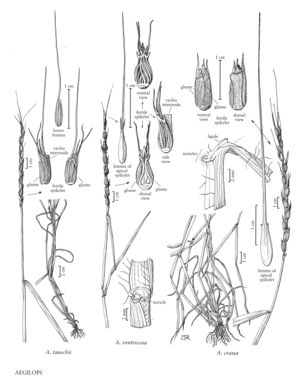Aegilops ventricosa
Culms 25-70 cm, erect to slightly geniculate at the base, forming few-to-many tillers. Sheaths with hyaline margins, ciliate; blades 7-15 cm long, 3-6 mm wide. Spikes 5-12 cm long, 0.3-0.6 cm wide, distinctly moniliform, with 3-11 fertile spikelets; rudimentary spikelets usually absent, sometimes 1-2; disarticulation in the rachises, the spikelets falling attached to the internodes above. Fertile spikelets 7-11 mm, urceolate, with 2-5 florets, the distal 1-2 florets sterile. Glumes of fertile spikelets mostly glabrous, veins setulose, apices truncate, with a sharply acute tooth to 3 mm; glumes of apical spikelets 7-8 mm, with a central tooth or awn flanked by 2 short teeth, central awns to 0.9 cm on the lower glumes, to 2 cm on the upper glumes; lemmas of fertile spikelets 8-10 mm, adaxial surfaces velutinous, apices awned, awns 0.3-3 cm, solitary; lemmas of apical spikelets awned, awns to 4 cm. Caryopses 5-7 mm, adhering to the lemmas and paleas. Haplomes DN. 2n = 28.
Discussion
In the Flora region, Aegilops ventricosa was collected once in New Castle County, Delaware. It is native to the Mediterranean area. The Arabic name, Oum el guemab, translates as 'mother of [durum] wheat'. It occasionally forms hybrids with Triticum durum, although the two species have no haplomes in common.
Selected References
None.
Lower Taxa
"decumbent" is not a number."-2(3)timesthelengthof" is not declared as a valid unit of measurement for this property.
